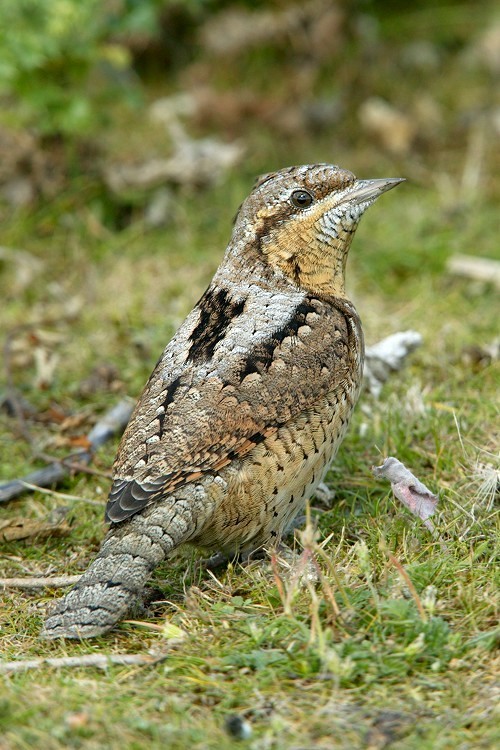| Line 1: | Line 1: | ||
;Jynx torquilla | ;Jynx torquilla | ||
| − | [[Image:120Wryneck E2D3291.jpg|thumb| | + | [[Image:120Wryneck E2D3291.jpg|thumb|550px|right|Photo by Nigel Blake<br />Photo taken: Norfolk, UK.]] |
| − | |||
| − | |||
==Identification== | ==Identification== | ||
| − | + | The Eurasian Wryneck, Jynx torquilla, is a species of wryneck in the family of woodpeckers. | |
| − | == | + | |
| + | Their bills are shorter and less dagger like than in the true woodpeckers. | ||
| + | ==Distribution== | ||
Breeds widely across Europe from northern Iberia and western France east to the Urals, Caspian and north Caucasus and across temperate Asia to China and northern Japan. In the north virtually absent from British Isles but breeds over most of Scandinavia except the higher mountains and the far north, and across Russia south of 650N. Breeds south to the northern coast of the Mediterranean from north-east Spain to northern Greece and on Corsica, Sardinia and Sicily. Also breeds sparingly in southern Portugal and in north Algeria. | Breeds widely across Europe from northern Iberia and western France east to the Urals, Caspian and north Caucasus and across temperate Asia to China and northern Japan. In the north virtually absent from British Isles but breeds over most of Scandinavia except the higher mountains and the far north, and across Russia south of 650N. Breeds south to the northern coast of the Mediterranean from north-east Spain to northern Greece and on Corsica, Sardinia and Sicily. Also breeds sparingly in southern Portugal and in north Algeria. | ||
| Line 12: | Line 12: | ||
Formerly a regular and fairly widespread breeder in Britain, now mainly a scarce passage migrant with 200-400 birds per year, mainly in August-October, with occasional summering birds and sporadic breeding records. Similar declines have been seen elsewhere in Europe, particularly in northern France and in North Sea countries. | Formerly a regular and fairly widespread breeder in Britain, now mainly a scarce passage migrant with 200-400 birds per year, mainly in August-October, with occasional summering birds and sporadic breeding records. Similar declines have been seen elsewhere in Europe, particularly in northern France and in North Sea countries. | ||
| − | + | ==Taxonomy== | |
| − | + | Kingdom: Animalia | |
| − | + | Phylum: Chordata | |
| − | ==Habitat== | + | Class: Aves |
| + | Order: Piciformes | ||
| + | Family: Picidae | ||
| + | Subfamily: Jynginae | ||
| + | Genus: Jynx | ||
| + | Species: J. torquilla | ||
| + | ==Habitat== | ||
Open woodland, deciduous or mixed, clearings and edges of forest, orchards, parks and large gardens. Nest in a tree-hole. Occurs in a range of more open habitats on passage including cultivated areas, close-cropped grassland, sand-dunes and shingle beaches. | Open woodland, deciduous or mixed, clearings and edges of forest, orchards, parks and large gardens. Nest in a tree-hole. Occurs in a range of more open habitats on passage including cultivated areas, close-cropped grassland, sand-dunes and shingle beaches. | ||
| + | ==Behaviour== | ||
| + | Their chief prey is ants and other insects, which they find in decaying wood or almost bare soil. They re-use woodpecker holes for nesting, rather than making their own holes. The eggs are white, as with many hole nesters. | ||
Revision as of 11:28, 20 July 2007
- Jynx torquilla
Identification
The Eurasian Wryneck, Jynx torquilla, is a species of wryneck in the family of woodpeckers.
Their bills are shorter and less dagger like than in the true woodpeckers.
Distribution
Breeds widely across Europe from northern Iberia and western France east to the Urals, Caspian and north Caucasus and across temperate Asia to China and northern Japan. In the north virtually absent from British Isles but breeds over most of Scandinavia except the higher mountains and the far north, and across Russia south of 650N. Breeds south to the northern coast of the Mediterranean from north-east Spain to northern Greece and on Corsica, Sardinia and Sicily. Also breeds sparingly in southern Portugal and in north Algeria.
Mainly a summer visitor but in the far south of range may be partially migratory or resident. Main autumn passage period is August-October, the return in April-May. Passage birds occur throughout Europe, North Africa, the Middle East and southern Asia. Winters in tropical Africa, India, South-East Asia, southern China and southern Japan.
Formerly a regular and fairly widespread breeder in Britain, now mainly a scarce passage migrant with 200-400 birds per year, mainly in August-October, with occasional summering birds and sporadic breeding records. Similar declines have been seen elsewhere in Europe, particularly in northern France and in North Sea countries.
Taxonomy
Kingdom: Animalia Phylum: Chordata Class: Aves Order: Piciformes Family: Picidae Subfamily: Jynginae Genus: Jynx Species: J. torquilla
Habitat
Open woodland, deciduous or mixed, clearings and edges of forest, orchards, parks and large gardens. Nest in a tree-hole. Occurs in a range of more open habitats on passage including cultivated areas, close-cropped grassland, sand-dunes and shingle beaches.
Behaviour
Their chief prey is ants and other insects, which they find in decaying wood or almost bare soil. They re-use woodpecker holes for nesting, rather than making their own holes. The eggs are white, as with many hole nesters.
Bird Song
<flashmp3>Jynx torquilla (song).mp3</flashmp3>
Listen in an external program




